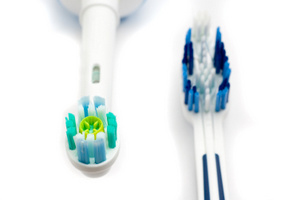

A toothbrush is a simple, yet vital part of our oral hygiene. Brushing our teeth is so important because it removes the day’s worth of plaque and bacteria that accumulates. Not removing bacteria and plaque from your teeth regularly can result in tooth decay and gum disease. Both of these oral health problems won’t just affect the aesthetics of your smile, but they will also affect how stable your teeth are.
Unhealthy teeth and gums can eventually lead to tooth loss if the problem is left untreated for an extended period of time. Although technology and improved dental techniques allow for dental implants to successfully restore missing teeth, preventative measures are the best way to keep your natural smile intact. Even humans thousands of years ago realized the importance of removing the sticky plaque from teeth, because toothbrushes have been around in some form for many years.
The History Of The Toothbrush
Brushing teeth can be seen throughout history, dating all the way back to the Babylonians and the Egyptians. Archaeologists have found evidence of tooth sticks alongside the tombs of the Egyptians. It’s believed that they would make these tooth sticks by fraying the ends of twigs to help brush away plaque on their teeth.
The Chinese were also concerned with their oral health and are believed to be the first civilization to invent a natural bristled toothbrush. They used bristles from pigs’ necks and then attached them to a handle made out of bone or bamboo. The Europeans soon took this idea from the Chinese and adapted it.
The Europeans instead used horse hairs because it was softer and more gentle on teeth. Other primitive materials used for toothbrushes include:
- Feathers
- Bones
- Porcupine Quills
The modern toothbrush wasn’t made until 1780 when William Addis of England used cattle bone and swine bristles to create a toothbrush. And then it wasn’t until 1844 when the first three-rowed toothbrush was invented.
Another breakthrough in toothbrushes was made with the invention of nylon. Nylon created the most modern toothbrush with nylon bristles in 1938. More improvements were made to the nylon-bristled toothbrush when inventors made a softer nylon to use for toothbrushes, which were preferred by most people. Toothbrushes have generally stayed the same since this improvement. However, there have been changes:
- The design of the handle.
- The shape of the toothbrush head.
- The thickness of bristles.
Although we now have the choice between manual and electronic toothbrushes, the basic design of them have stayed the same since the 1930s.
Evolution Of Toothpaste
The use of toothpaste is believed to date back to the Egyptians in 5000 BC when they used a paste before ever using a toothbrush. Ingredients used for toothpastes have varied throughout different societies and time periods, but the goal to clean and whiten teeth has stayed the same.
The Greeks and Romans believed using an abrasive toothpaste was the best way to remove bacteria and plaque from their teeth. They would use ingredients like crushed bones and oyster shells. Romans would add additional ingredients to treat bad breath including powdered charcoal and bark. The Chinese also had their own spin on toothpaste by adding ingredients like ginseng, salt and herbal mints.
Modern toothpaste didn’t start evolving until the 1800s and most toothpastes were actually in powder form until the 1850s. During the early 1800s, toothpaste would often contain soap and betel nut. Toothpaste in a jar wasn’t actually introduced until the 1850s, and Colgate took this idea to mass produce toothpaste in jars in 1873. Nearly twenty years later Colgate debuted toothpaste in a tube, just as you find toothpaste nowadays.
The next advancement in toothpaste was made after 1945 when soap was replaced with other ingredients like sodium lauryl sulphate, an ingredient you will likely find in today’s toothpaste. Since this change in toothpaste, manufacturers wanted to differentiate toothpastes for different types of oral health problems. For example, herbal toothpaste like Tom’s first became available in 1975. The first edible toothpaste meant for children was designed in 1987. Tubes of toothpaste currently offer different formulations which include:
- Children’s toothpaste
- Herbal toothpastes
- Toothpaste for sensitivity
- Whitening toothpaste
- Tartar control toothpaste
Contact Our Office In Vincennes, IN
Toothbrushing and the use of toothpaste have been around throughout history and is one of the best ways to avoid the dangers of oral health problems. Tooth loss can result in loss of remaining teeth, overall health issues and a decrease in self-confidence. For individuals in this situation, dental implants can restore missing teeth to give a long-lasting and natural-looking smile. Patients love the beautiful results they achieve through the dental implant process. If you’re interested in beginning your journey to a beautifully restored smile, contact our office to schedule your no-obligation consultation with Dr. Eric Herman.
